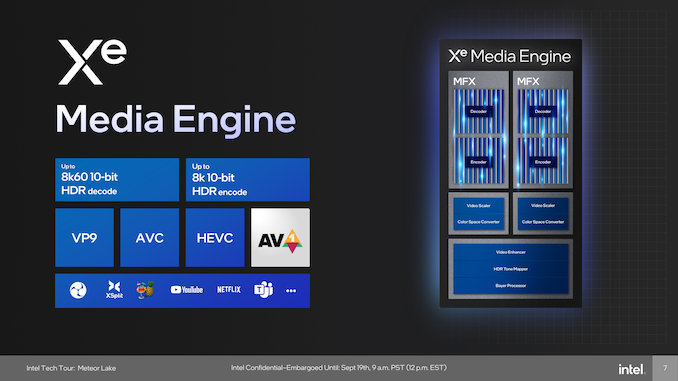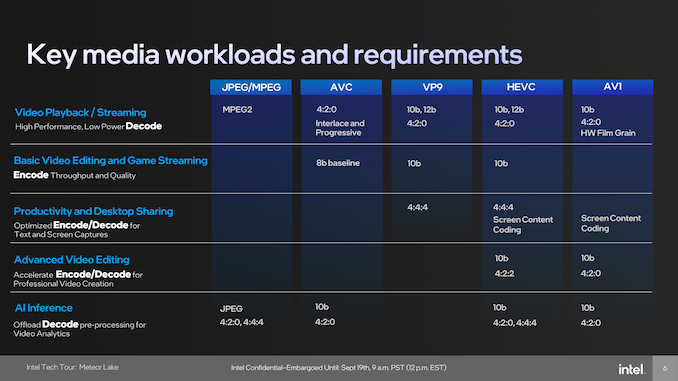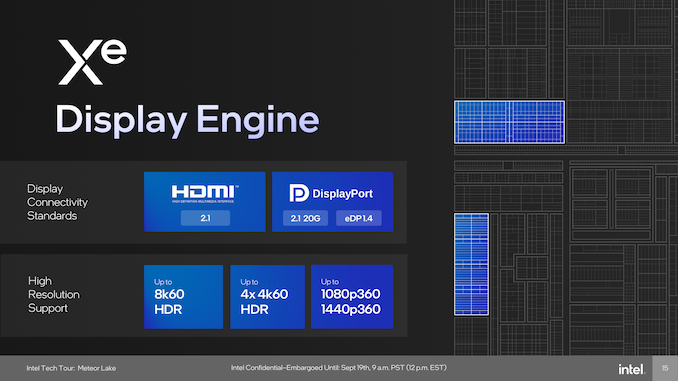Intel Unveils Meteor Lake Architecture: Intel 4 Heralds the Disaggregated Future of Mobile CPUs
by Gavin Bonshor on September 19, 2023 11:35 AM ESTSoC Tile, Part 3: Disaggregating Xe Media and Display Engine From Graphics
As we noted earlier, Intel has completely redesigned its graphics, media, and display engine for Meteor Lake and, as such, separates all three entities from each other. While we'll cover the new graphics tile next, we'll start with everything that's not part of the graphics tile. Opting for a disaggregated architecture allows Intel to not only shuffle things around from an IP perspective but also allows Intel to integrate new IPs such as cores, graphics, and I/O as and when advancements have been made at a silicon level, but the design allows unties Intel from being limited to a specific manufacturing process.
Starting things off, we have the Xe Media Engine, which is embedded within the SoC tile. Within the Xe Media Engine are two Multi-Format Codecs (MFX), designed and responsible for all the encoding and decoding tasks. Intel's Meteor Lake with Xe supports the latest codecs ranging from AV1 (decode and encode), HEVC, AVC, and VP9, with up to 8K60 HDR decode supported. For encoding, there's support for up to 8K resolutions with 10-bit color and HDR. Aiming to improve power efficiency on-chip with encode/decode workloads, having a dedicated Media Engine separate from the graphics allows Intel to find granular power savings as things are directed to the Xe Media Engine, which means the graphics tile doesn't need to be powered up to accomplish encode or decode tasks.
The Xe Media Engine provides various functionalities across a large spectrum of different video codecs. This ranges from JPEG/MPEG and AVC to the more advanced VP9, HEVC, and AV1 codecs. Designed to give Meteor Lake a solid level of computational efficiency for video processing, the Xe Media Engine balances the gaps between high-performance output and power efficiency, rendering it particularly well-suited for various applications, from real-time video streaming to high-fidelity playback. There's also support for diverse color formats and bit depths, including but not limited to 4:2:0 at 10-bit and 12-bit, which means it's versatile for video editing and video encoding and should satisfy content creator's needs.
Xe Display Engine: Also Within the SoC
Much like the Xe Media Engine, the Xe Display Engine is also found within the SoC tile on Meteor Lake. Decoupling this directly from the graphics tile and embedded into the SoC allows it to communicate directly with the Xe Media Engine, saving power and improving overall battery life. The engine supports up to four display pipes, two of which have been designed and optimized for low power consumption, further boosting overall efficiency for Meteor Lake.
Looking at compatibility, the Xe Display Engine looks to use the latest connections and ports, including native support for HDMI 2.1, DisplayPort 2.1, Embedded DisplayPort (eDP) 1.4. and even DSC 1.2a. Via these blocks, Meteor Lake can support displays up to 8K60 HDR, or up to 4 x 4K60 HDR displays, and this is on top of 1080p360 and 1440p360 too. This gives Meteor Lake substantial display and multimedia device support, including current and up-and-coming panels.













107 Comments
View All Comments
kwohlt - Tuesday, September 19, 2023 - link
The market for people who find TB4 to be insufficient is too small to delay MTL for themExotica - Wednesday, September 20, 2023 - link
Source or market research please ? I have the feeling that many enthusiasts will not be interested. Because of missing TB5. And also because of its ipc improvements (or lack thereof) vs raptor lake.Meteor lake certainly is impressive. But it seems to be less about raw performance and more about the process improvement. Foveros. Chiplets. Euv. New manufacturing abilities. AI engine. Power efficiency. Newish gpu.
But from a generational uplift perspective, from a raw cpu performance to the thunderbolt io, I t’s not much of an upgrade for enthusiasts. Intel should’ve just launched MTL in Dec and then announced TB5 in January. What was the reason to announce TB5 before the MTL reveal?
I guess we will have to wait on arrow lake mobile (if that’s a thing) or lunar lake for TB5 on laptops.
kwohlt - Wednesday, September 20, 2023 - link
You need Market Research to tell you TB4 bandwidth is sufficient for majority of users? 40Gb/s can drive easily gigabit interent and multiple monitors. Most jobs do not require more. At the Fortune 500 I manage IT for, we still haven't even switched to thunderbolt as 3.1 docks are more than sufficient.There's market research on TB4 trends for purchase, that i'm not going to pay for, so we'll just have to settle on "Intel's market research determined that delaying their next gen product line for this 1 feature, potentially causing delays across OEMs 2024 product lines in the process, was not worth it"
PeachNCream - Thursday, September 21, 2023 - link
"...many enthusiasts..."While that segment might be outspoken, the percentage of the overall market is tiny and the percentage that cares among that fraction is even smaller. Basement dweller computer nerds and the e-sports people they idolize don't buy the hundreds of thousands of units that a computer manufacturer purchases. Sure, they get a minor head nod from the company to keep them from slobbering and raving about being ignored, but that's done because it's cheap to coddle them with marketing speak and make them believe features are targeted at them so their ego balloons aren't popped and sites like this have a bone or two to throw them once in a while, but ultimately, no one cares what they want as long as they fanboy argue in favor of their preferred brand with other nerds that like the competition.
TheinsanegamerN - Thursday, September 21, 2023 - link
Exactly. TB5 is exciting and meteor lake is mostly DoA without it. Who would invest thousands into a machine that cant make use of newer functionality?KaarlisK - Tuesday, September 19, 2023 - link
Was this just written by having an AI interpret the slides? And then OCR failed?"This means that higher Out-of-Service (OoS) work is allocated to P-cores for more demanding and intensive workloads, while lower Quality-of-Service (QoS) workloads are directed to E-cores, primarily to save power"
Ryan Smith - Tuesday, September 19, 2023 - link
No, it was done by a sleep-deprived human.KaarlisK - Tuesday, September 19, 2023 - link
Thank you for the explanation.The problem is, I caught at least three more mistakes like this, where a wrong assumption is made about what the text on a slide actually means. In which case (knowing that I'm not an expert), how can I be certain that there aren't many more mistakes that I haven't spotted?
We do come to Anandtech for in-depth analysis, which requires that trust.
Ryan Smith - Tuesday, September 19, 2023 - link
The blunt answer is that we're imperfect (to err is human). We've made mistakes in the past and will continue to do so in the future. But we always own up to those mistakes, and will correct anything if we catch it (or if it gets pointed out).DannyH246 - Tuesday, September 19, 2023 - link
Wow! Intel have some revolutionary ideas here!! Their chiplet approach will change the industry.Would be what i'd have said if they'd have presented this 6 years ago. My response today is...meh.